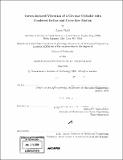Vortex-induced vibration of a circular cylinder with combined in-line and cross-flow motion
Author(s)
Dahl, Jason (Jason Michael)
DownloadFull printable version (89.69Mb)
Alternative title
VIV of a circular cylinder with combined in-line and cross-flow motion
Other Contributors
Massachusetts Institute of Technology. Dept. of Mechanical Engineering.
Advisor
Michael S. Triantafyllou.
Terms of use
Metadata
Show full item recordAbstract
Deep water, string-like, marine risers subject to strong ocean currents, suffer from vortex-induced vibrations (VIV), where vortex shedding interacts with the structural properties of the riser, resulting in large amplitude vibrations in both in-line and cross-flow directions. This thesis presents an experimental approach to model and quantify the motions and hydrodynamic forces associated with the excitation of a deep water marine riser by considering the combined cross-flow and in-line excitation of a rigid cylinder. For deep water risers, the excitation of the structure through vortex shedding can lead to a condition of dual resonance, where the vortex shedding frequency locks in to the effective natural frequency (adjusted for added mass effects) in both in-line and cross-flow directions. Large motion amplitudes are observed in this condition along with large magnitude third harmonic forces in lift. Flow visualization of the wake behind the cylinder in combined in-line and cross-flow motion, shows that third harmonic forces are caused by the relative motion of the cylinder with respect to a '2P' (two pairs of vortices) or '2T' (two triplets of vortices) shedding pattern, since vortices shed in these modes remain in close proximity to the cylinder over one cycle of motion. Forced motions of a cylinder with combined in-line and cross-flow motions are performed, generating a database of force coefficients to be used in riser VIV prediction. The assumption of dual resonance is used to predict the motions of an elastically mounted rigid cylinder using measurements from forced cylinder motions. Two passive vortex suppression methods are studied for eliminating combined cross-flow and in-line cylinder motions and suppressing large third harmonic forces.
Description
Thesis (Ph. D.)--Massachusetts Institute of Technology, Dept. of Mechanical Engineering, 2008. Includes bibliographical references (p. 249-256).
Date issued
2008Department
Massachusetts Institute of Technology. Department of Mechanical EngineeringPublisher
Massachusetts Institute of Technology
Keywords
Mechanical Engineering.